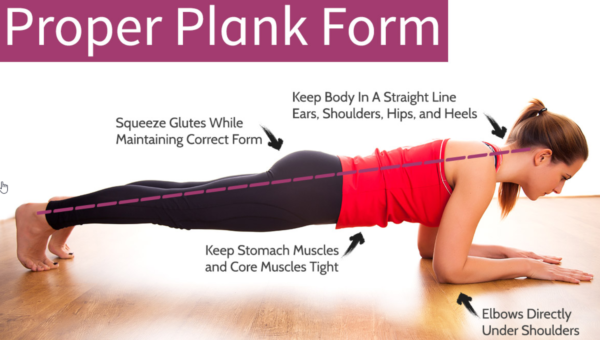Plank: How This Exercise Can Transform Your Entire Body
The plank exercise might look simple and easy but soon as you give it a try it can be quite the opposite. The same thing goes if you think that it doesn’t affect the body so much, but in reality, you’re activating all the muscle groups and it’s extremely effective and beneficial.
If you’re serious about working out and transforming your body, this exercise will do wonders for you!
It will help you strengthen and tone the core muscles in your abdomen, hips, and back. With origins in yoga, the abdominal plank is easy to do and can be adapted to provide benefits to even the most physically fit among us.
More than just an abdominal exercise, the plank offers several benefits to getting fit and staying healthy. Let’s see them.
Tones the belly
Since the plank exercise works all the muscles in your core, it can tone and tighten your belly better than any sit-up.
Abdominal exercises can only work a small part of the trunk, focusing mainly on the upper abdominal muscles. Planks, on the other hand, work both your upper and lower abs, as well as your obliques, so you can say “goodbye” to those “love handles” that keep you from getting the slim, toned waist you want (no matter how many crunches you do). ).
Toning your abs and burning belly fat is just the tip of the iceberg when it comes to plank benefits.
Reduces and cures back pain
By strengthening your core muscles and tightening your abs, planks can help relieve your back muscles while also getting them in shape.
Performing the plank exercise can help reduce stress on your back when you’re at rest, so this benefit extends well beyond the time you’re doing the exercise.
Improves flexibility, balance and posture
When you improve the tone of your core muscles, you can feel the benefits throughout your body. The abdominal plank exercise not only strengthens and reduces pain but also helps to make the body more flexible, improve balance and create a better posture for the spine, whether you are sitting or standing.
Perhaps the best thing about planks is that they can be infinitely modi
fied, so people of all fitness levels can find the type of plank that works for them.
Beginners can start with a basic plank position, and work their way up to modified forms that can challenge even the most athletic of bodies.

How to do planks correctly
Using the good form is crucial when doing the plank exercise. The good news is that doing a plank abdominal correctly is not very difficult, it just requires practice and concentration at first. Here we explain how to make a plank:
- Lie on the floor, face down.
- Position your arms so that your shoulders are directly above your elbows, with your wrists aligned with your elbows in a straight line (see image above).
- Squeeze your abdominal muscles and glutes (the muscles that make up your buttocks) and hold the position for as long as you can. Gradually lengthen the position holding time.
- Rest about a minute between repetitions.
Avoid these common mistakes when doing planks
Although doing the plank exercise is not difficult once you know how to do it, there are some common mistakes that can diminish the benefits of the abdominal plank, and even injure you. Make sure to avoid the following:
Mistake #1 – Don’t let your lineup falter
Dropping your hips, head, or shoulders during a plank can mess with your spinal alignment and lead to injury. If you need a break, carefully come out of the plank position and rest before trying again.
Mistake #2 – Not putting your hands too close together
This puts stress and strain on your shoulders and can hurt more than help. Remember that your hands should be in line with your elbows, which should be in line with your shoulders.
Mistake #3 – Not holding your breath
Breathing normally is important when doing planks, as you need oxygen for any exercise to be effective. Remember to breathe.
Mistake #4 – Don’t keep the iron on for too long
A little goes a long way!